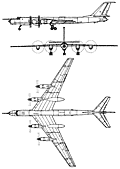 |
Tupolev Tu-1421968 |  |
| MARITIME PATROL AIRCRAFT | Virtual Aircraft Museum / USSR / Russia / Tupolev |
 |
In the mid-1960s, the Soviet Navy developed a requirement for a long-range anti-submarine and maritime patrol aircraft to supplement the IL-38 medium-range aircraft. With the Tu-95 and Tu-114 in operation, Tupolev was asked to prepare proposals. Nikolai Bazenkov was appointed chief designer for the project, which was given the number 142. He took the basic Tu-95 design but omitted all the strategic equipment. The wing was redesigned with increased span, up from 50.05m to 51.10m, which allowed more fuel to be carried, and with increased camber. Much of the defensive weaponry was also removed. Then he added the electronic equipment needed for its new role. The prototype Tu-142 made its first flight from Zhukovski in July 1968. After flight tests by the designers and the NIl VVS, the aircraft was put into production at Kuibyshev and later at Taganrog. It entered service with Naval Long Distance Aviation in 1972; it was then, and still is, the world's largest anti-submarine aircraft. It served alongside the smaller IL-38, which was effectively the Soviet equivalent of the US Navy's P-3 Orion; but its long-range capability made it able to launch an attack on a submarine 5,000km from the aircraft's base. With improvements in electronics, work began in 1973 on an improved version, the Tu-142M, and its first flight was made on 4 November 1975. The -142M was fitted with electronic equipment capable of early detection of low-noise submarines, a new and more accurate INS navigation system and automated radio communications. Its surveillance system worked on a 360° arc, and was more capable than that of the IL-38 at detecting magnetic abnormalities. Data was transferred immediately by satellite link back to base. With a capability to patrol for seventeen hours, the aircraft was provided with bunks for crew rest. Its internal fuel load was seventy tonnes, and it was equipped for in-flight refuelling which could extend the patrol duration beyond the seventeen hours when needed. The VMS based its Tu-142s, which were given the NATO codename 'Bear F', in the Northern and Pacific regions; some were also based in Cuba and Vietnam until 1990, when political developments prompted their return to Russia. Production continued at Taganrog until 1988, with one aircraft per month being completed. Total production run at both factories was 225 aircraft, including eight delivered to the Indian Navy starting in the mid- 1980s and continuing until 1988. The standard armament of the Tu-142 was two GSh-23 cannons mounted in the tail for defensive use. It could carry up to eight Kh-35 anti-shipping cruise missiles (NATO code AS-17) mounted on pylons under the wing, and internally, 450mm calibre anti-submarine torpedoes and/or 533mm calibre anti-shipping torpedoes. Depth charges could also be dropped. With a combat load of 11,340kg, its maximum range was 12,550km. Normal take-off weight was 170 tonnes, but 188 was possible with little difficulty.
|  COMPANY PROFILE | |||||||||||||||||||||||||||||||||||||||||||||||||||||||||
 |

|

